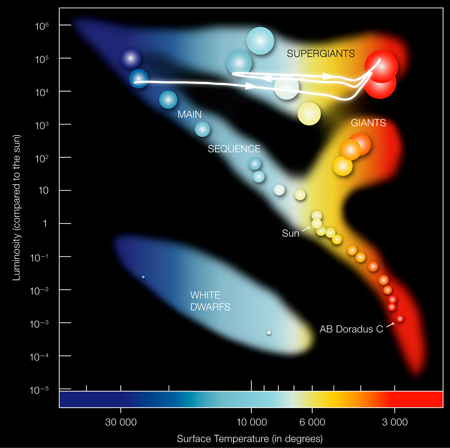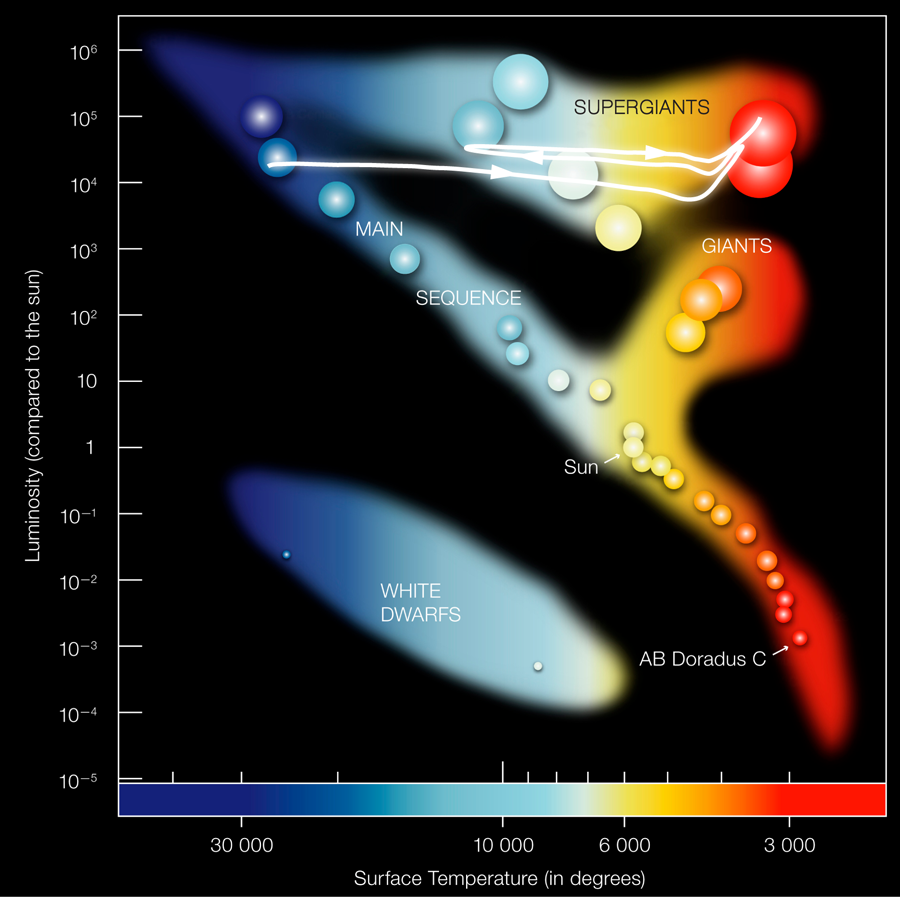Particle Physics in the Sky
In the cosmos, the most-weakly-interacting particles may have the strongest presence. Dark matter particles are estimated to constitute more than of the matter in the Universe, but are so weakly interacting with other matter that physicists have been unable to figure out what they are. Likewise, neutrinos are the most difficult to detect of the known particles, yet they are known to dominate the late stages of a star’s evolution and likely drive the supernova explosion that follows the core collapse of a dying massive star.
Within this particle landscape is the axion, a hypothetical spin-zero boson with very small mass that is considered a strong contender for dark matter [1–4]. Axions have never been detected, but the theory that describes them predicts they are created when photons interact with magnetic fields or electric charges—a condition overwhelmingly met in stars. Since this process would drain energy from stars, astrophysicists can observe the evolution of stars to place bounds on the axion production rate [5]. In Physical Review Letters, Alexander Friedland of Los Alamos National Laboratory, New Mexico, and colleagues use this argument to provide the strongest upper limit to date on the strength of the interaction between axions and electromagnetic fields [6]. Their results provide feedback into theoretical models of axions and can be used to assess the sensitivity of axion detectors. On another level, their work highlights the role of stars as particle-physics laboratories, complementary to those on Earth.
At the beginning of its life, a star like our Sun burns hydrogen. The more massive a star is, the brighter it shines and the hotter its surface. This relationship is captured in the Hertzsprung-Russell (HR) diagram (see Fig. 1), which plots the brightness of known stars on the vertical axis and their surface temperatures (or color) on the horizontal axis. On such a plot, hydrogen-burning stars fall along the “main sequence.” After hydrogen is used up, helium burning takes over in the center, hydrogen burns in a shell, and the stellar envelope expands: the star ends up in the red-giant region of the diagram with a colder surface temperature (red color). Normally, it is at this point that a massive star would begin its “blue loop,” a short phase of contraction and re-expansion at the end of helium burning that takes the star horizontally across the HR diagram toward a hotter surface (blue color) and back (Fig. 1). Based on a numerical analysis of these evolution sequences, Friedland et al. show that, if the photon-axion coupling were sufficiently strong, excessive axion losses would prevent stars in the range between and solar masses from following this trajectory, which would contradict a range of astronomical observation.
The authors show that the very existence of the blue-loop phase puts a severe limit on the strength of the axion-photon coupling. Generically, axions should decay into two photons, although at an extremely low rate. The same interaction also means an axion could convert into a photon (or the other way round) in the presence of electric or magnetic fields—the latter playing the role of one of the two decay photons. As a result, thermal photons in the hot plasma within a star could convert to axions in the fluctuating electric fields provided by charged particles. It is this process that produces axions in stars and efficiently drains energy, provided the axion-photon coupling is sufficiently strong.
Friedland et al.’s work complements other tests of the hypothesis that axions are abundantly produced in stars. For example, following decades of successfully observing solar neutrinos, researchers have also tried to detect axions directly from the Sun. The search for solar axions began at Brookhaven National Laboratory in the US and the University of Tokyo, but the largest “axion helioscope” is CERN’s Axion Solar Telescope (CAST), which has taken data since 2003 [7]. CAST consists of one of the Large Hadron Collider’s decommissioned superconducting prototype magnets, which is oriented toward the Sun and designed to look for x rays that would arise from solar axions turning into photons as they travel meters down the magnet bores. This conversion would reverse the original production process of axions from photons in the Sun. CAST has not found a signal, though Friedland et al.’s new blue-loop bound on the axion-photon coupling shows that CAST was not sensitive enough. The International Axion Observatory (IAXO), which is currently in the design phase, will be a much bigger helioscope and have a sensitivity far exceeding CAST or the new blue-loop limit [8].
Neutrino astronomy is another powerful tool with which to learn about axions. When a star collapses, it emits a huge amount of energy in the form of a short burst of neutrinos. If axions were produced in nucleon interactions, they would carry away some of this energy and shorten the neutrino burst. On 23 February 1987, astrophysicists observed about two-dozen neutrinos over seconds from supernova SN 1987A. The duration and strength of this burst agreed well with what was expected, suggesting that not too much energy could have been produced in the form of axions [5]. Several multipurpose neutrino megadetectors are in operation worldwide; proposals for others that would register a high-statistics neutrino signal from a galactic supernova (expected to occur every few decades) are under consideration. Besides learning about the astrophysics of core collapse and the properties of neutrinos, these detectors could validate and improve upon the axion limits obtained from observing SN 1987A.
The SN 1987A bound is, however, not restrictive enough to say that axions don’t strongly affect the cooling of neutron stars. Moreover, if axions interact with electrons (which is quite possible, but not required by current theories) they could also noticeably impact the evolution of other stars than the ones considered by Friedland et al. There exist some indications that white dwarfs—stellar remnants too light to become a neutron star—might be cooling faster than expected by standard processes alone, an effect that could be attributed to axion emission. This hypothesis certainly remains speculative for now, but could be tested with the IAXO project by looking for solar axions [8]. It could also be tested with more careful studies of globular cluster stars that are currently under way at the Pontifical Catholic University in Chile, using modern astronomical data.
The biggest prize would be to not only detect axions but to identify them as dark matter. If axions are the particles that make up dark matter, it would mean their interactions are too feeble for stars to produce them efficiently but strong enough that they could emerge from the early Universe in just the right amount to account for all the observed dark matter. Friedland et al.’s result, which sets an upper limit on axion-photon interactions, leaves this possibility open. Moreover, if axions are the dark matter, they must be streaming through our laboratories in large numbers. Axion dark matter experiments, like the CAST helioscope, look for the axions’ predicted conversion into photons in the presence of a magnetic field [9]. A vastly improved version of the Axion Dark Matter eXperiment (ADMX) is being commissioned at the University of Washington, Seattle. It uses a high-quality microwave cavity in a -Tesla magnetic field as a conversion volume and a novel, nearly quantum-limited microwave amplifier [10]. Associated developments are being pursued at Yale, while researchers at DESY in Hamburg and at the Max Planck Institute for Physics in Munich [11] are working on new ideas to search for axion dark matter.
The search for axions and their particle relatives remains a showcase example of the power of the “heavenly laboratories” to learn about particle-physics conjectures. Friedland et al.’s new argument provides another beautiful case in point. The next generation experiments could still turn up solar axions. The new round of axion dark matter searches are poised to find them, if indeed they are the main stuff making up our universe.
References
- J. Jaeckel and A. Ringwald, “The Low-Energy Frontier of Particle Physics,” Ann. Rev. Nucl. Part. Sci. 60, 405 (2010)
- G. Raffelt and L. Rosenberg, et al.“Axions and Similar Particles,” in J. Beringer (Particle Data Group), Phys. Rev. D 86, 010001 (2012)
- A. Ringwald, “Exploring the Role of Axions and Other WISPs in the Dark Universe,” Phys. Dark Univ. 1, 116 (2012)
- M. Kawasaki and K. Nakayama, “Axions: Theory and Cosmological Role,” arXiv:1301.1123
- G. Raffelt, “Astrophysical Axion Bounds,” Lect. Notes Phys. 741, 51 (2008)
- A. Friedland, M. Giannotti, and M. Wise, “Constraining the Axion-Photon Coupling with Massive Stars,” Phys. Rev. Lett. 110, 061101 (2013)
- M. Arik et al. (CAST Collaboration), “CAST Search for sub-eV Mass Solar Axions with 3-He Buffer Gas,” Phys. Rev. Lett. 107, 261302 (2011)
- I. G. Irastorza et al., “Towards a New Generation Axion Helioscope,” J. Cosmol. Astropart. Phys. 1106, 013 (2011)
- P. Sikivie, “Experimental Tests of the Invisible Axion,” Phys. Rev. Lett. 51, 1415 (1983); 52, 695(E) (1984)
- S. J. Asztalos et al. (ADMX Collaboration), “A SQUID-Based Microwave Cavity Search for Dark-Matter Axions,” Phys. Rev. Lett. 104, 041301 (2010)
- D. Horns et al. “Searching for WISPy Cold Dark Matter with a Dish Antenna,” arXiv:1212.2970





